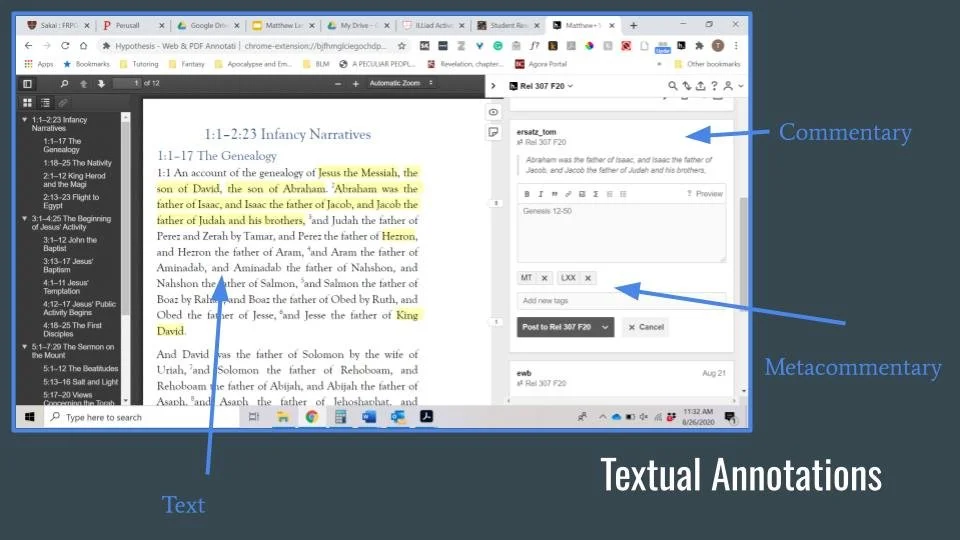The St. Lawrence Annotation Project: The Gospel of Matthew in its Jewish Context (Seminar, 2020)
This research project is the fruit of a seminar on Jesus and the Gospels taught at St. Lawrence University in the Fall of 2020. In Jesus and the Gospels, students focus on one portrayal of Jesus in one of the Gospels. For Fall 2020, we studied Jesus in the Gospel of Matthew with a focus on Second Temple Judaism.
This research project has two overlapping components: (1) a collaborative study of the Gospel of Matthew using Hypothes.is, a collaborative asynchronous text annotation platform and (2) short video presentations on topics in and sources of Second Temple Judaism. The goal was to produce a free and open-access resource for academics, citizen-scholars, and religious leaders around the globe to understand the Gospel of Matthew in the context of first-century CE Judaism.
Encoding Revelation
The printed bible, especially the critical editions favored by scholars, has proven to be an incredibly durable and informative research artifact. However, the constraints of the page limit our ability to see the "hypertextuality" of scripture, the use of one text by another. Online editions, however, circumvent these physical restrictions. Free from the spatial constraints of printed texts, online editions can provide fuller, dynamic references. Allusions in the body text can be color-coded, and the marginal references can be hyperlinked to source texts in the MT and LXX. Online editions also provide flexibility, as users can toggle citations of individual texts, selecting the source texts and text-forms they prefer. My digital project "Encoding Revelation" is a sandbox for Revelation's use of scripture. Such a presentation makes vivid the connections present in the biblical author’s mind, the “hypertextual” connections of literary theorists such as Gerard Gennette and Umberto Eco. Moreover, digital editions can be made freely and openly accessible to global academics, clergy, lay leaders, and lifelong learners with limited access to current scholarship
My work on this project so far has focused on Revelation, and I will be expanding to narrative texts that speak to communities using God’s word to define themselves in times of division, starting with the Gospel of Matthew and the Johannine corpus. Pauline corpus has served as the crucible for New Testament intertextuality, and this project would be well-suited seminars on Paul’s letters and the Apostle’s use of Scripture.
The text of Revelation is derived from Diego Santos's transcription of Eberhard Nestle's Greek New Testament (1904). A scanned image of Nestle's text (reprinted 1913) is available at archive.org. Paragraphs breaks, punctuation, and diacritics are according to the SBL Greek New Testament. Copyright © 2010 Society of Biblical Literature and Logos Bible Software. Hebrew text taken from the electronic version of the Leningrad Codex hosted at tanach.us and maintained by the J. Alan Groves Center for Advanced Biblical Research. Greek texts texts taken from CATSS Computer Assisted Tools for Septuagint Studies hosted at en.katabiblon.com. Base texts taken from Septuaginta, ed. A. Rahlfs (Stuttgart: Württembergische Bibelanstalt, 1935; repr. in 9th ed., 1971). This work is licensed under a Creative Commons Attribution-NonCommercial-ShareAlike 4.0 International License by C. Thomas Fraatz. Powerpoint slides are available here.

